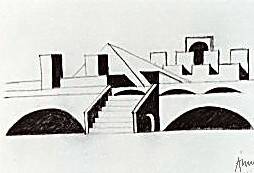ARCHITECTURE - THE OLDEST HUMAN ARTIFACT

Akin to hunting tools and caves, architecture by virtue of its sheltering aspect is a human artifact of use. Ultimately, architects are concerned with building places for a purpose. For architects to build with conviction, it is important that they develop a philosophy of “building”. Such a philosophy must inevitably articulate universal concepts if it is indeed to be considered a “philosophy of architecture”. This is so because architecture is essentially universal. It is at this juncture of universality that the human being enters the scope of architecture and becomes its common theme, its nexus.
While it is true that cultural differences play a vital role in shaping the specific architectural elements of a region, the point that is often missed is that it is the cultural commonalities on which the foundations of humanity are based, and so it is these commonalities that persist in architecture universally. Thus, for example, it is the common roots of the idea of privacy, neighborhood, community, individual etc. that provide the human theme to all cultures. Of course, human emotions and their comprehensibility can be manipulated by specific cultural beliefs and traditions; however, their root cause is a common one. For instance, the notion of “ascension of spirit” is a metaphor common to all known religions, no matter how many different liturgical expressions it may manifest. This is evident in religious buildings of the ancients as well as those of today where the skyward rise of pagodas, ziggurats, pyramids, turrets, vaults, arches, minarets, steeples, spires, or domes emphasize this metaphor. Culture itself is not a constant thing; it is an ever transforming reality and the human being is it’s only constant.
In this respect, then, the human brain and its emotional structure are fundamentally unchanged. Symbolically, it is easier for all of us to exchange ideas what ever our background may be. Our minds comprehend intangibles subconsciously in a manner that our conscious senses often do not. Therefore, if a philosophy is founded on this recognition and articulates fundamental principles that persist in the realm of architecture, it strives towards universal concepts. It thus seeks to excavate those timeless constants that serve as a reminder of the human element in architecture. Hence, it does not reduce architecture to an elitist symbol or a dated order of design guided purely by a technologically based value system. Rather, it seeks to define architecture as the product of a conscious human activity, discernible even in the most primordial human artifact.
Ayub H. Patel
Create Your Own Website With Webador